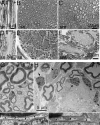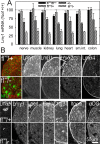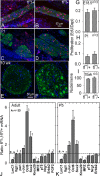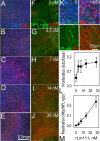Schwann cell myelination requires integration of laminin activities
- PMID: 22767514
- PMCID: PMC3500866
- DOI: 10.1242/jcs.107995
Schwann cell myelination requires integration of laminin activities
Abstract
Laminins promote early stages of peripheral nerve myelination by assembling basement membranes (BMs) on Schwann cell surfaces, leading to activation of β1 integrins and other receptors. The BM composition, structural bonds and ligands needed to mediate this process, however, are not well understood. Mice hypomorphic for laminin γ1-subunit expression that assembled endoneurial BMs with reduced component density exhibited an axonal sorting defect with amyelination but normal Schwann cell proliferation, the latter unlike the null. To identify the basis for this, and to dissect participating laminin interactions, LAMC1 gene-inactivated dorsal root ganglia were treated with recombinant laminin-211 and -111 lacking different architecture-forming and receptor-binding activities, to induce myelination. Myelin-wrapping of axons by Schwann cells was found to require higher laminin concentrations than either proliferation or axonal ensheathment. Laminins that were unable to polymerize through deletions that removed critical N-terminal (LN) domains, or that lacked cell-adhesive globular (LG) domains, caused reduced BMs and almost no myelination. Laminins engineered to bind weakly to α6β1 and/or α7β1 integrins through their LG domains, even though they could effectively assemble BMs, decreased myelination. Proliferation depended upon both integrin binding to LG domains and polymerization. Collectively these findings reveal that laminins integrate scaffold-forming and cell-adhesion activities to assemble an endoneurial BM, with myelination and proliferation requiring additional α6β1/α7β1-laminin LG domain interactions, and that a high BM ligand/structural density is needed for efficient myelination.
Figures








Similar articles
-
Expression of laminin receptors in schwann cell differentiation: evidence for distinct roles.J Neurosci. 2003 Jul 2;23(13):5520-30. doi: 10.1523/JNEUROSCI.23-13-05520.2003. J Neurosci. 2003. PMID: 12843252 Free PMC article.
-
Schwann cells synthesize alpha7beta1 integrin which is dispensable for peripheral nerve development and myelination.Mol Cell Neurosci. 2003 Jun;23(2):210-8. doi: 10.1016/s1044-7431(03)00014-9. Mol Cell Neurosci. 2003. PMID: 12812754
-
α6β1 and α7β1 integrins are required in Schwann cells to sort axons.J Neurosci. 2013 Nov 13;33(46):17995-8007. doi: 10.1523/JNEUROSCI.3179-13.2013. J Neurosci. 2013. PMID: 24227711 Free PMC article.
-
Integrating Activities of Laminins that Drive Basement Membrane Assembly and Function.Curr Top Membr. 2015;76:1-30. doi: 10.1016/bs.ctm.2015.05.001. Epub 2015 Jun 25. Curr Top Membr. 2015. PMID: 26610910 Review.
-
Laminin-deficient muscular dystrophy: Molecular pathogenesis and structural repair strategies.Matrix Biol. 2018 Oct;71-72:174-187. doi: 10.1016/j.matbio.2017.11.009. Epub 2017 Nov 27. Matrix Biol. 2018. PMID: 29191403 Free PMC article. Review.
Cited by
-
Schwann cell myelination.Cold Spring Harb Perspect Biol. 2015 Jun 8;7(8):a020529. doi: 10.1101/cshperspect.a020529. Cold Spring Harb Perspect Biol. 2015. PMID: 26054742 Free PMC article. Review.
-
Peripheral nerve development in zebrafish requires muscle patterning by tcf15/paraxis.Dev Biol. 2022 Oct;490:37-49. doi: 10.1016/j.ydbio.2022.07.001. Epub 2022 Jul 9. Dev Biol. 2022. PMID: 35820658 Free PMC article.
-
Thermoelectric Freeze-Casting of Biopolymer Blends: Fabrication and Characterization of Large-Size Scaffolds for Nerve Tissue Engineering Applications.J Funct Biomater. 2023 Jun 20;14(6):330. doi: 10.3390/jfb14060330. J Funct Biomater. 2023. PMID: 37367294 Free PMC article.
-
Necl-4/SynCAM-4 is expressed in myelinating oligodendrocytes but not required for axonal myelination.PLoS One. 2013 May 20;8(5):e64264. doi: 10.1371/journal.pone.0064264. Print 2013. PLoS One. 2013. PMID: 23700466 Free PMC article.
-
Linker proteins restore basement membrane and correct LAMA2-related muscular dystrophy in mice.Sci Transl Med. 2017 Jun 28;9(396):eaal4649. doi: 10.1126/scitranslmed.aal4649. Sci Transl Med. 2017. PMID: 28659438 Free PMC article.
References
-
- Benninger Y., Thurnherr T., Pereira J. A., Krause S., Wu X., Chrostek–Grashoff A., Herzog D., Nave K. A., Franklin R. J., Meijer D.et al. (2007). Essential and distinct roles for cdc42 and rac1 in the regulation of Schwann cell biology during peripheral nervous system development. J. Cell Biol. 177, 1051–1061 10.1083/jcb.200610108 - DOI - PMC - PubMed
Publication types
MeSH terms
Substances
Grants and funding
LinkOut - more resources
Full Text Sources
Other Literature Sources
Molecular Biology Databases

